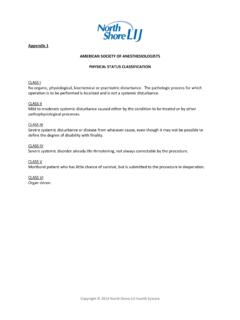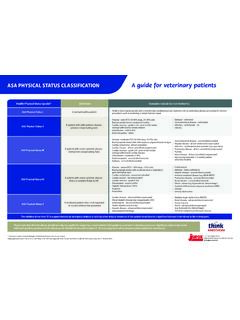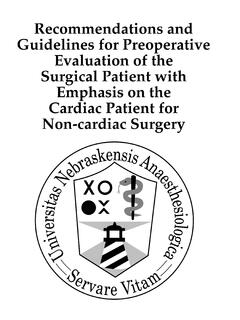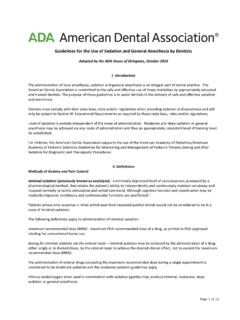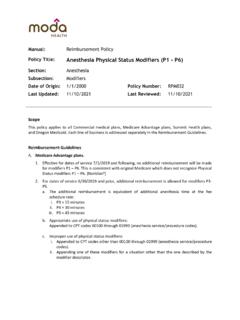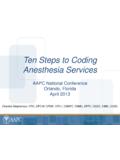Transcription of Guidelines on the Management of Postoperative Pain - RSDSA
1 Guidelines on the Management of Postoperative PainManagement of Postoperative Pain: A Clinical Practice GuidelineFrom the american Pain society , the american society of RegionalAnesthesia and Pain Medicine, and the american society ofAnesthesiologists Committee on Regional Anesthesia, ExecutiveCommittee, and Administrative CouncilRoger Chou,*Debra B. Gordon,yOscar A. de Leon-Casasola,zJack M. Rosenberg,xStephen Bickler,{Tim Brennan,kTodd Carter,**Carla L. Cassidy,yyEva Hall Chittenden,zzErnest Degenhardt,xxScott Griffith,{{Renee Manworren,kkBill McCarberg,**Robert Montgomery,yyyJamie Murphy,zzzMelissa F. Perkal,xxxSanthanam Suresh,{{{Kathleen Sluka,kkkScott Strassels,**Richard Thirlby,yyyyEugene Viscusi,zzzzGary A. Walco,xxxxLisa Warner,{{{{Steven J. Weisman,kkkkand Christopher L. Wuzzz*Departments of Medicine, and Medical Informatics and Clinical Epidemiology, Oregon Health and Science University,Pacific Northwest Evidence Based Practice Center, Portland, of Anesthesiology and Pain Medicine, University of Washington, Seattle, of Anesthesiology and Pain Medicine, Roswell Park Cancer Institute and University at Buffalo School ofMedicine and Biomedical Sciences, Buffalo, New Integrated Service Network, Department of Veterans Affairs and Departments of Physical Medicine andRehabilitation and Anesthesiology, University of Michigan, Ann Arbor, Michigan.}}}}}}}}}}
2 {Pediatric Surgery, University of California, San Diego, San Diego, of Anesthesia, University of Iowa Hospitals and Clinics, Iowa City, Iowa.**Department of Anesthesia, University of Cincinnati, Cincinnati, of Veterans Affairs, Veterans Health Administration, Washington, of Palliative Care, Massachusetts General Hospital, Boston, Management Division, United States Army Medical Command, San Antonio, Texas.{{Critical Care Medicine, Walter Reed Army Medical Center, Bethesda, of Pediatrics, University of Connecticut School of Medicine, Mansfield, Connecticut.** american Academy of Pain Medicine, San Diego, of Anesthesiology, University of Colorado, Denver, Denver, of Anesthesiology and Critical Care Medicine, Johns Hopkins University, Baltimore, of Surgery, Veterans Affairs Medical Center, West Haven, Connecticut.{{{Department of Pediatric Anesthesia, Children s Hospital of Chicago, Chicago, of Physical Therapy and Rehabilitation, University of Iowa, Iowa City, Iowa.}}}}}}
3 **College of Pharmacy, University of Texas at Austin, Austin, Weight Loss Surgery Center, Virginia Mason Medical Center, Seattle, of Anesthesiology, Thomas Jefferson University, Philadelphia, of Anesthesiology and Pain Medicine, Seattle Children s Hospital, Seattle, Washington.{{{{Department of Veteran Affairs, Phoenix, of Anesthesiology, Children s Hospital of Wisconsin, Wauwatosa, October 28, 2015; Revised December 11, 2015; AcceptedDecember 14, for this guideline was provided by the american Pain guideline was submitted for approval by the partnering organiza-tions, but the content of the guideline is the sole responsibility of the au-thors and panel panelists were required to disclose conflicts of interest within the pre-ceding 5 years at all face-to-face meetings and before submission of theguideline for publication, and to recuse themselves from votes if aconflict was present.}}}}
4 Conflicts of interest of the authors and panelmembers are listed inSupplementary Appendix data accompanying this article are available online reprint requests to Roger Chou, MD, 3181 SW Sam Jackson ParkRoad, Mail code BICC, Portland, OR 97239. 2016 by the american Pain Journal of Pain, Vol 17, No 2 (February), 2016: pp 131-157 Available online :Mostpatients whoundergosurgicalproceduresexperience acutepostoperativepain, butev-idence suggests that less than half report adequate Postoperative pain relief. Many preoperative, intra-operative, and Postoperative interventions and Management strategies are available for reducing andmanaging Postoperative pain. The american Pain society , with input from the american society of Anes-thesiologists, commissioned an interdisciplinary expert panel to develop a clinical practice guideline topromote evidence-based, effective, and safer Postoperative pain Management in children and guideline was subsequently approved by the american society for Regional Anesthesia.
5 As part ofthe guideline development process, a systematic review was commissioned on various aspects relatedto various interventions and Management strategies for Postoperative pain. After a review of the evi-dence, the expert panel formulated recommendations that addressed various aspects of postoperativepain Management , including preoperative education, perioperative pain Management planning, use ofdifferent pharmacological and nonpharmacological modalities, organizational policies, and in the preoperative period with an assessment of the patient and development of a plan of caretailored to the individual and the surgical procedure involved. The panel found that evidence supportsthe use of multimodal regimens in many situations, although the exact components of effective multi-modal care will vary depending on the patient, setting, and surgical procedure.
6 Although these guide-lines are based on a systematic review of the evidence on Management of Postoperative pain, thepanel identified numerous research gaps. Of 32 recommendations, 4 were assessed as being supportedby high-quality evidence, and 11 (in the areas of patient education and perioperative planning, patientassessment, organizational structures and policies, and transitioning to outpatient care) were made onthe basis of low-quality :This guideline, on the basis of a systematic review of the evidence on Postoperative painmanagement, provides recommendations developed by a multidisciplinary expert panel. Safe and effec-tive Postoperative pain Management should be on the basis of a plan of care tailored to the individual andthe surgical procedure involved, and multimodal regimens are recommended in many situations. 2016 by the american Pain SocietyKey words: Postoperative pain Management , clinical practice Guidelines , analgesia, education, multi-modal therapy, patient assessment, regional analgesia, neuraxial than 80% of patients who undergo surgicalprocedures experience acute postoperativepain and approximately 75% of those with post-operative pain report the severity as moderate, severe, ,96 Evidence suggests that less than half ofpatients who undergo surgery report adequatepostoperative pain controlledpain negatively affects quality of life, function, and func-tional recovery, the risk of post-surgical complications,and the risk of persistent postsurgical preoperative, intraoperative, and postoperativeinterventions and Management strategies are availableand continue to evolve for reducing and managing post-operative pain.
7 The american Pain society (APS), withinput from the american society of Anesthesiologists(ASA), commissioned a guideline on Management ofpost-operative pain to promote evidence-based, effective, andsafer Postoperative pain Management in children andadults, addressing areas that include preoperative educa-tion, perioperative pain Management planning, use ofdifferent pharmacological and nonpharmacological mo-dalities, organizational policies and procedures, and tran-sition to outpatient care. The ASA published a practiceguidelineforacutepainmanagementi ntheperioperativesetting in 20126; the APS has not previously publishedguidelines on Management of Postoperative pain. Aftercompletion, the guideline was also reviewed for approvalby the american society of Regional Anesthesia and CompositionThe APS, with input from the ASA, convened a panel of23 members with expertise in anesthesia and/or painmedicine, surgery, obstetrics and gynecology, pediatrics,hospital medicine, nursing, primary care, physicaltherapy, and psychology to review the evidence andformulate recommendations on Management ofpostoperative pain (seeSupplementary Appendix 1fora list of panel members).
8 Three cochairs ( [selectedby the APS], [selected by the ASA], and )were selected to lead the panel, which also includedthe APS Director of Clinical Guidelines Development( ).Target Audience and ScopeThe intent of the guideline is to provide evidence-based recommendations for Management of postopera-tive pain. The target audience is all clinicians whomanage Postoperative pain. Management of chronicpain, acute nonsurgical pain, dental pain, trauma pain,and periprocedural (nonsurgical) pain are outside thescope of this ReviewThis guideline is informed by an evidence review con-ducted at the Oregon Evidence-Based Practice Center132 The Journal of PainManagement of Postoperative Painand commissioned by the Oregon Evidence-Based Practice Center, the panel developed the key ques-tions, scope, and inclusion criteria used to guide the evi-dence review. Literature searches were conductedthrough November 2012.
9 The full search strategy,including the search terms and databases searches, isavailable in the evidence review. Investigators reviewed6556 abstracts from searches for systematic reviews andprimary studies from multiple electronic databases,reference lists of relevant articles, and suggestions fromexpert reviewers. A total of 107 systematic reviews and858 primary studies (not included in previously publishedsystematic reviews) were included in the searches were conducted throughDecember 2015. New evidence was reviewed and judgedto be consistent with the recommendations in this guide-line, which was updated with new citations as of the Evidence andRecommendationsThe panel used methods adapted from the Grading ofRecommendations Assessment, Development, and Eval-uation Working Group to rate the recommendationsincluded in this recommendationreceived a separate grade for the strength of the recom-mendation (strong or weak) and for the quality of evi-dence (high, moderate, or poor) (SupplementaryAppendix 2).
10 In general, a strong recommendation ison the basis of the panel s assessment that the potentialbenefits of following the recommendation clearlyoutweigh potential harms and burdens. In light of theavailable evidence, most clinicians and patients wouldchoose to follow a strong recommendation. A weakrecommendation is on the basis of the panel s assessmentthat benefits of following the recommendationoutweigh potential harms and burdens, but the balanceof benefits to harms or burdens is smaller or evidence isweaker. Decisions to follow a weak recommendationcould vary depending on specific clinical circumstancesor patient preferences and values. For grading the qual-ity of a body of evidence that supports a recommenda-tion, we considered the type, number, size, and qualityof studies; strength of associations or effects; and consis-tency of results among Development ProcessThe guideline panel met in person in August 2009 andJanuary 2011.





